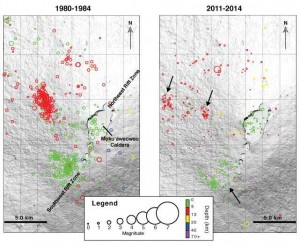VOLCANO WATCH: Mauna Loa Showing Signs of Stirring
After a 30-year repose, Mauna Loa may be slowly stirring to life. While there are no signs of impending eruption, the Hawaiian Volcano Observatory has recorded an increased level of seismic activity on the flanks and summit of Mauna Loa over the past 13 months.
Four distinct earthquake swarms — clusters of earthquakes occurring closely in time and location — have occurred since March 2013.
Each swarm began with earthquakes northwest of the summit (Moku‘āweoweo Crater) at 4 to 15 km (2.5-9 mi) deep, followed by shallow earthquakes at the summit from several days to one month later. These earthquakes have all been less than magnitude-2.2, except for a magnitude-3.5 earthquake on May 9, 2014.
The recent swarms have not been associated with the deformation of the ground surface that we would expect from intrusion of significant amounts of magma into shallow levels beneath Mauna Loa.
However, ground deformation indicating shallow magma accumulation has been measured during many of the past 30 years, including two episodes of very rapid inflation immediately following the most recent eruption in 1984, and again from 2004-2006. The latter inflation started with a swarm of deep, long-period earthquakes at 45 km (28 mi) under the volcano.
Prior to the 1984 eruption, seismicity was elevated for at least three years, with 28 earthquakes greater than magnitude 3, and 2 earthquakes greater than magnitude 4.
The magnitude-6.7 earthquake on November 16, 1983, may also have been triggered by the pressurizing magma system of Mauna Loa. Earthquakes prior to the 1984 eruption were typically located northwest of the summit at depths greater than 5 kilometers (3 miles) and on the upper Southwest Rift Zone at depths less than 5 km (3 mi).
The seismic network that monitors Mauna Loa has been significantly improved since 1984.
As part of the American Recovery and Reinvestment Act in 2011, all of the seismic stations in the HVO seismic network were upgraded to use technology that results in less noise and better recordings.
The current seismic network is better able to detect and locate smaller earthquakes than the network prior to these upgrades.
It is likely that many of the small earthquakes that we currently observe would not have been detected by HVO’s seismic monitoring prior to the 1984 eruption.
Though the size and number of earthquakes observed over the past 13 months has been significantly smaller than those observed in the three years prior to the 1984 eruption, they have been occurring in the same general areas of the volcano.

These maps (click to enlarge) of Mauna Loa show the location, strength and depths of earthquakes (see legend). The one on the left shows earthquakes from Jan. 1, 1980 to March 25, 1984. On the right are earthquake locations from Jan. 1, 2011 to July 12, 2014. Black arrows are the locations of earthquake swarms that have been recorded in the past 13 months. USGS/HVO graphic.
The swarm in September-October 2013 occurred on the northwest flank, the same location as one of the swarms that occurred prior to the 1984 eruption. The May 9, 2014, magnitude-3.5 earthquake occurred in the same area of the upper Southwest Rift Zone as many magnitude 3 or greater earthquakes prior to the 1984 eruption.
Interestingly, the March 2013 and April 2014 swarms occurred on the northwest flank in areas that were not active prior to the 1975 or 1984 eruptions.
So why are earthquakes happening in these different areas?
Mauna Loa consists of a hot and plastic core that is composed of overlapping dikes intruded during the construction of the volcano’s edifice.
Stresses arising from an intrusion of magma or gases under the volcano may be transmitted through the mushy core to the cooler and more brittle crust outside the core of the volcano.
The earthquake activity present during the past 13 months has consisted entirely of earthquakes arising from brittle failure of the crust. The swarms below 4 km (2.5 mi) deep have occurred outside the core of the volcano and, thus, are consistent with a model requiring rocks around the core to adjust to stress changes within the core.
The Hawaiian Volcano Observatory continues to monitor Mauna Loa for signs of an impending eruption. The likelihood of detecting a short-term change in activity that would lead to a successful eruption forecast is enhanced with a quality geophysical network that can monitor changes in earthquake occurrence, ground deformation and gas chemistry both in the summit and rift zones of Mauna Loa.
For more information of the activity at Mauna Loa or any other Hawaiian volcano, see http://hvo.wr.usgs.gov.
Kīlauea activity update
A lava lake within Halema‘uma‘u produced nighttime glow that was visible via HVO’s webcam during the past week. The lava lake level rose during the week, reaching about 40 meters (130 feet) below the rim of the Overlook crater by Thursday, June 12.
On Kīlauea’s East Rift Zone, the Kahauale‘a 2 flow remains active. The flow front stalled at 8.8 km (5.5 miles) northeast of its vent on Pu‘u ‘Ō‘ō in mid-May. On Friday, June 6, the most distant active flows were 6.5 km (4.0 miles) northeast of Pu‘u ‘Ō‘ō. Several small spatter cones within the Pu‘u ‘Ō‘ō crater also continued to produce glow.
There was one earthquake in the past week with more than 3 felt reports. On Friday, June 6, 2014, at 4:42 p.m., HST, a magnitude-4.1 earthquake occurred 5 km (3 mi) southeast of the town of Maunaloa, Moloka`i, at shallow depth.
—
Volcano Watch is a weekly column provided by scientists at the Hawaiian Volcano Observatory headquartered at the summit of Kilauea volcano. Visit the HVO website (http://hvo.wr.usgs.gov) for current Kīlauea, Mauna Loa, and Hualālai activity updates, recent volcano photos, recent earthquakes, and more; call (808) 967-8862 for a Kīlauea summary; email questions to [email protected].













